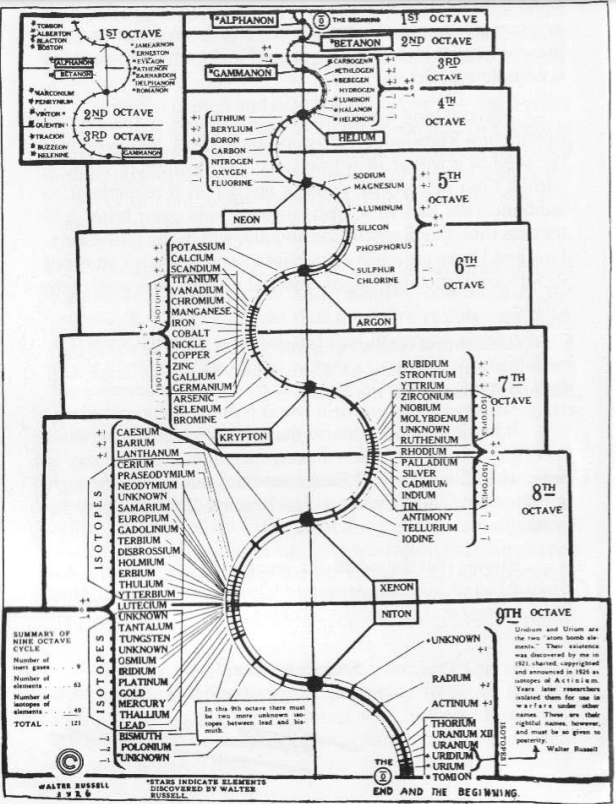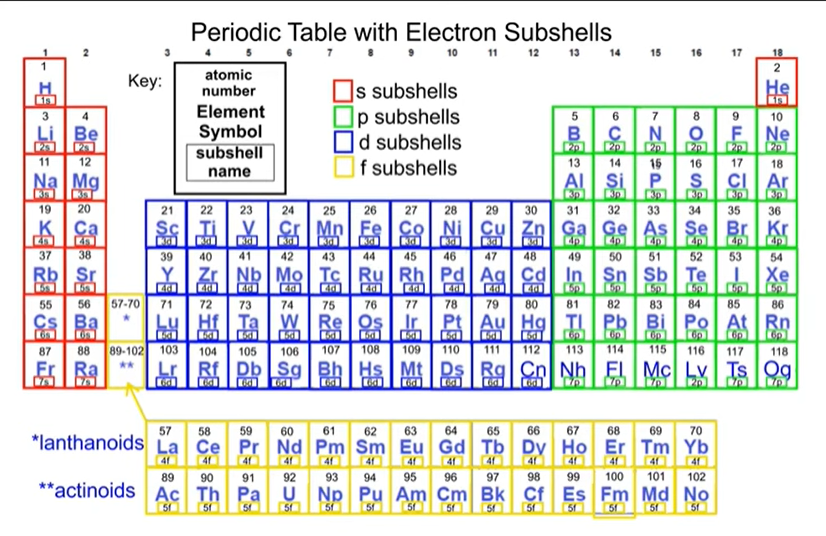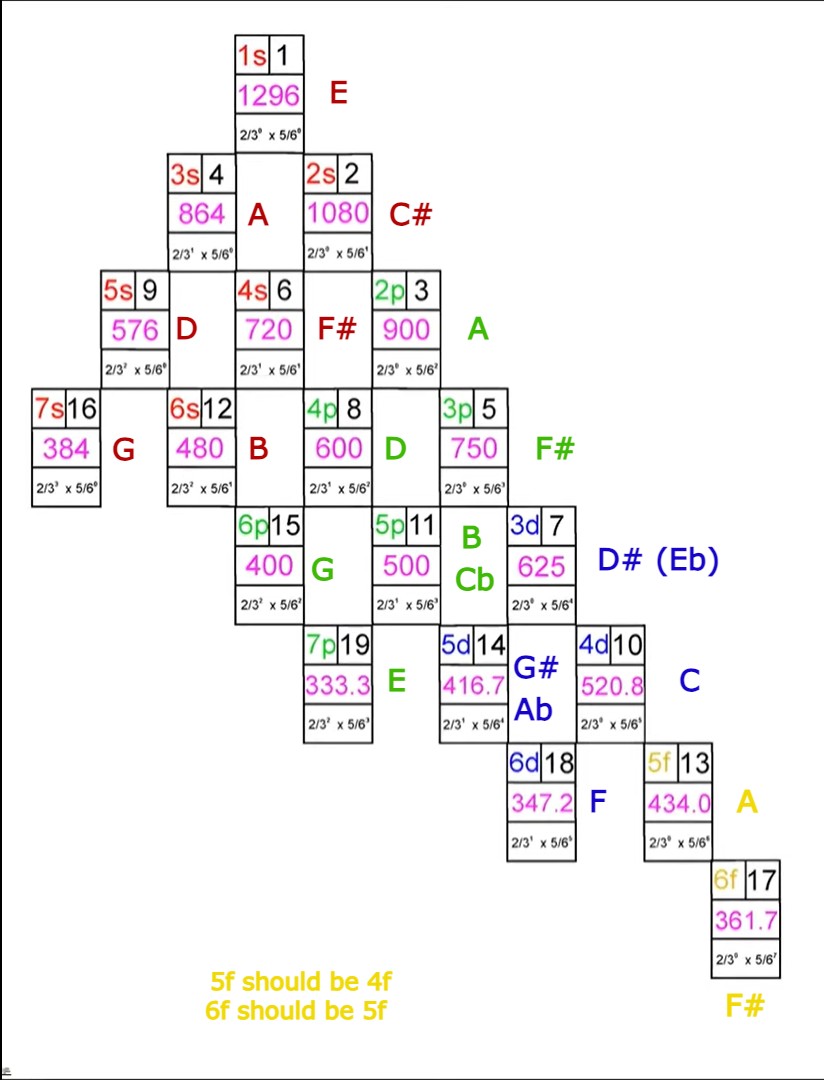Everything in the universe is based on patterns and cycles. When they are evident, it's a path that leads to possible discoveries. When patterns and cycles cease to exist, that's when research sits on a shelf until further understanding is revealed. In the Frequencies of Creation series, I hypothesize that it's possible to explain creation through music theory. In this article, we'll explore a connection between the periodic table of elements and music.
Although I began looking at the periodic table several years ago, it was in November of 2023 when I found materials that could answer my question about musical connections to the periodic table. Then, several readers sent me the interview between Terrence Howard and Joe Rogan in May of 2024. I don't know either of those individuals and have absolutely no understanding of where they come from or what they stand for. I was only interested in hearing the section of the video where Terrence Howard connected the periodic table of elements to musical octaves. I did listen to the entire interview, which was fascinating. I have no opinion about the final two hours of the video but there was intriguing information presented that sits on a shelf for a later time. Here, we address on the periodic table portion of that interview and compare it to other materials I've found.
The video "Musical Patterns and Cycles of the Periodic Table" compliments this article. I created the video first and then came back to write this article. Key points from the video are listed below the video.
As an academic, I'm curious about how the universe works. The creative part of me enjoys thinking outside the box where I don't limit myself to what everyone else thinks. If we aren't willing to expand our thinking process, we get stuck in a rut. The greatest inventors and thinkers of all time dared to think beyond the current known information. Some of it brought us to where we are today. What wasn't good fell by the wayside. Time eventually reveals truth from fiction.
When articles and videos that seem far out are sent to me, I choose to watch and listen to everything while gathering the nuggets of information that help with my quest. I don't judge the people or what they say because time will tell if it's truth or fiction.
Russell A. Smith
The work of Russell Smith came to me quite by accident. In the fall of 2023, I continued my research on the periodic table and a video popped up as a suggestion so I watched it. The video is titled "Mapping Gurdjieff's Enneagram to the Periodic Table of Elements, and all creation." After doing a bit of research on George Gurdjieff, I learned he was an out-of-the-box thinker from Russia. He was a philosopher, spiritual teacher, and composer. As a composer in the early 20th century, he understood music theory. That meant his description of musical ideas in his writings was probably accurate.
Russell Smith took Gurdjieff's work a step further by assigning specific Hz frequencies based on musical ratios (Pythagorean tuning) and in the process, realized there was a connection to the periodic table. I purchased Smith's book, Gurdjieff: Cosmic Secrets, and began the process of determining the exact note names of the Hz frequencies, which wasn't as easy as expected. I'll explain why that is later in the article.
Walter Russell and His Periodic Table
Walter Russell is another man from the early 20th century who was a sculptor, mystic, and author from the United States. Eventually, he turned his attention to the periodic table of elements and created the version shown in the Rogan/Howard interview. I incorrectly state in the video above that Russell WAS NOT a musician but after further research, I found that he WAS a church organist and conductor. That means he could read music and had to understand some music theory. He eventually became a leader in the Science of Man movement.
Russell copyrighted his spiral shaped periodic table in 1926 and discusses it in his book, The Universal One. It's also available as a PDF online. Through reading this book, I realized his use of the word "octave" actually means "cycle." Octaves are cycles and they are full of patterns of scales and intervals. It's my belief that Terrence Howard (who doesn't understand music) literally believed the term "octave" meant the 8 notes of a musical scale instead of Russell's intent that octaves are actually cycles.

Figure 1
Figure 1 is a screenshot of Walter Russell's spiral periodic table from his book, The Universal One. Note that on the right, he lists the "octaves." When replacing the word "octave" with "cycle," it begins to make more sense.
The elements are listed according to atomic weight from Hyrdogen all the way down to the last element known at that time. What's curious to me is that with his method, he predicted "unknown" elements in the correct places that were discovered later. That alone tells me there's something about this periodic table that may have musical merit.
We'll explore the possible musical components to Russell's periodic table in another article.
Russell Smith's Periodic Table

Smith's periodic table (above) uses the colors of the subshells rather than the colors for the various "periods." There are four subshell groups: Supreme, Prime, Distant, and Final. More details are provided on these family groups in the Frequencies of Creation: Part 7 article.
Russell Smith and George Gurdjieff
As stated previously, Smith based his periodic table on the work of George Gurdjieff. Because Smith already had the specific Hz frequencies figured out, it was a matter of assigning each frequency a specific musical note. Gurdjieff and Smith both state they began with 1 Hz (C) and determined the other pitches from 1 Hz. To find the actual note names, I did the following:
- Opened up TWO online tone generators.
- Input the first frequency into the first tone generator.
- Input the second frequency into the second tone generator.
- Listened for the interval the two tones created.
- Wrote down the interval and figured out the note name based on the interval the two frequencies created.
- Compared the Hz frequencies in Smith's chart to my modified Pythagorean tuning chart in the A=432 concert pitch. This is how I confirmed the note names and determined which concert pitch ran through each family group (subshells).
My results are shown below in Figure 2 and Figure 3.
NOTE: In my video, I provide a second version of Figure 2 where it's transposed into the key of F#. At first, I didn't realize I'd put the F# version into my slide show where I show the chords created from within the family groups. I caught the mistake in the video and then focused only on Smith's version. Figure 2 starts on the note E and represents the key of E as the starting point. It is the version used by Smith. I compare the F# and E versions in the video to demonstrate the pattern remains the same no matter what the starting pitch is.
Figure 2 is spreadsheet format to show the intervals and chords for each subshell (family).
Figure 3 is Smith's diagram where I've added the notes to match Hz frequencies.

Figure 2

Figure 3
Connecting Musical Patterns Within Smith's Periodic Table
Once all the musical frequencies had matching pitches, it was a matter of looking for the patterns and cycles. Finding the musical pitches was a bit tricky! Look at Figure 2 again. Notice that the intervals are either Major 3rds (M3) or minor 3rds (m3). Major 3rds are the trickiest interval to tune! In a nutshell, Major 3rds must be brought down in pitch before they're in tune, which changes the actual Hz number. Therefore, that's why it required actually listening to each interval between the various Hz frequencies to determine the name of the lower note.
Below are patterns and cycles I noticed after writing in the note names next to the frequencies in Figure 3.
Conclusion
Through Smith's periodic table, I can conclude there are plenty of patterns and cycles that clearly line up with the natural laws of music. In a sense, it appears as if the periodic table provides a lesson in music theory that's hidden within. Is this a coincidence or by divine design?
At what point do we chalk something up to chance or begin to look a bit deeper into why certain things show up in the strangest places? As I state in the video, once a pattern is recognized, keep following it to find cycles and how it all connects to natural laws within the universe. The next piece involves connections between disciplines outside of music. Math is all about numbers. Hz frequencies are numbers that are assigned musical notes. There's patterns within those notes the create pleasant music. And, it's apparent they are embedded into the periodic table.
What does this have to do with the elements? That question is for scientists who understand the periodic table to answer. As I also state in the video, when academics of various disciplines come together with their puzzle pieces, we may find unexpected answers because no single person or discipline has all the answers! I share how the recent science of "archeaoacoustics" is a new science that brings together geologists, acoustic specialists, cosmologists, musicians, archealogists, ethnomusicologists, and others as well.
When academics and scientists can compare notes (no pun intended), it seems we'll find a more complete picture of how the universe came to exist as we know it. Walter Russell's periodic table may add another layer to the mix because it comes from a different perspective. I do know that Terrence Howard's version needs adjustment but that doesn't necessarily mean everything he says in the three-hour interview should be thrown out the window. Like many things we don't understand, let them sit on a shelf until greater levels of understanding present themselves. That often comes with a transformation process within our mindsets.
Be sure to CLICK HERE for an explanation of Smith's periodic table in the Frequencies of Creation, Part 7 article. At the bottom of that article are all the sources (including the first six articles in the series). As I continue to do more research, I still believe going down the path of explaining the universe through music theory is one to follow because patterns, cycles, and natural laws keep showing up. As long as that happens, I'll follow the trail.
Del
May, 2024
NOTE: None of the information in this series or any other article on this site may be used without permission! You may share the articles but if you wish to quote my work in your own writing, it is "good form" to cite any materials that aren't your own.

